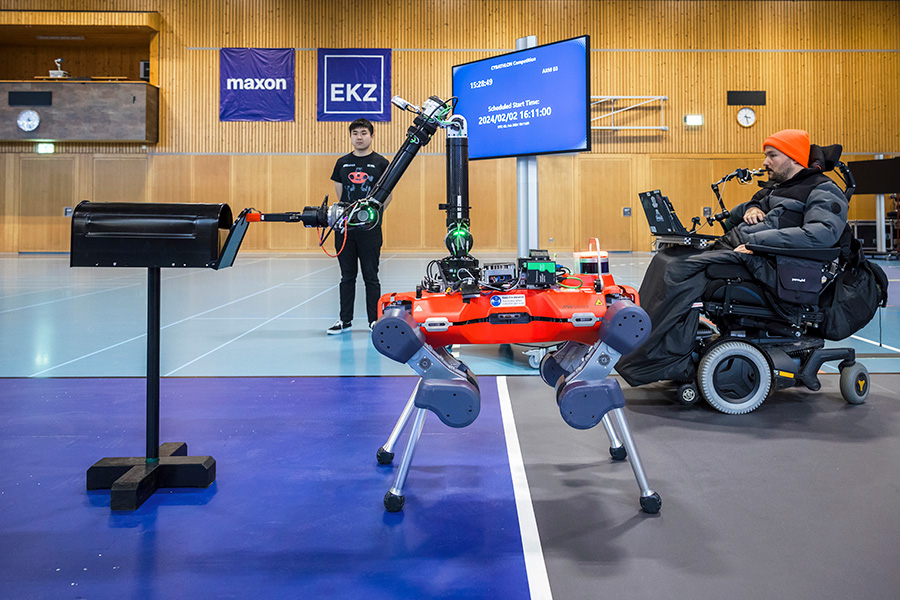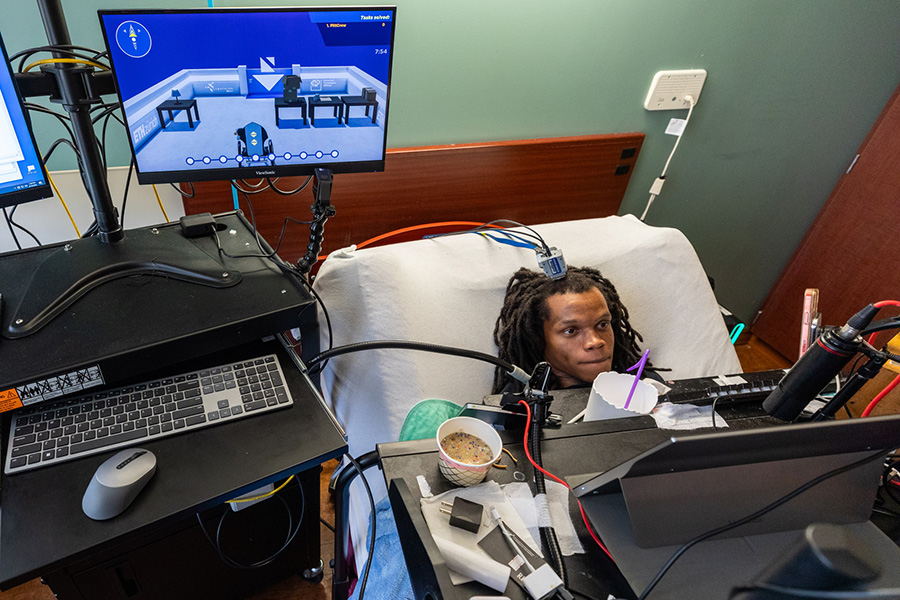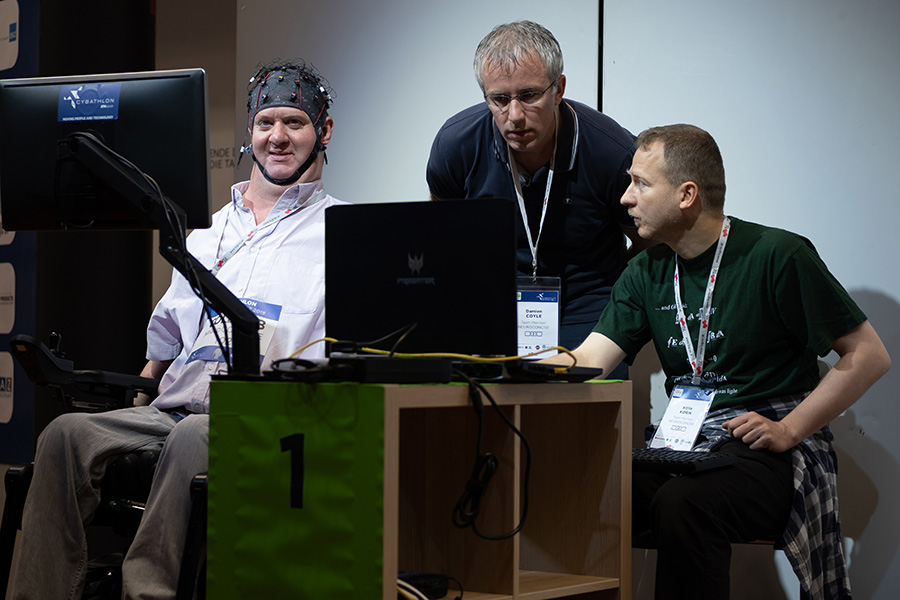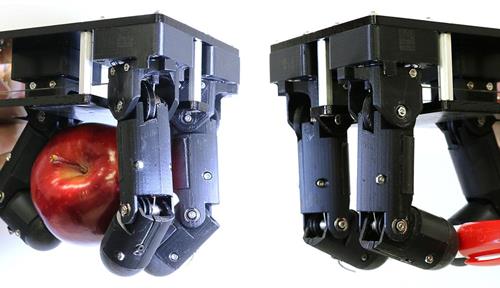Next week, several intrepid cyber-athletes will race to carry out routine household tasks via a computer avatar: They’ll have to open a locked door, for example, and hold a cup under an ice dispenser to collect a precise number of cubes. Those tasks may sound easy, but there’s a catch: The athletes, who are all paralyzed from the neck down, will attempt to complete them using only the power of their thoughts.
This is the brain-computer interface race, one of several challenges in the upcoming 2024 Cybathlon taking place in Switzerland (and remotely) October 25 to 27. The competition, held every four years, pushes the limits of what human bodies and machines can do together, showcasing proficiency at the basic tasks of daily life.
The Cybathlon has no affiliation with the Paralympics and there are big differences between them, says Robert Riener of ETH Zurich, an expert on robotics and rehabilitation who launched the Cybathlon a decade ago. “The Paralympics are more athletic, and more about rewarding the strongest and fastest — but that excludes many people,” Riener says. In the Paralympics, people can use a prosthesis, but all devices must be passive: no motor, no display, no sensors.
By contrast, the Cybathlon is unabashedly “technotopian,” says Riener. It is about the fullest possible collaboration of technology and human effort. For that reason, the competitors are not called athletes: They are “pilots.” The device they are piloting might be a prosthetic arm, for example, or an exoskeleton or a robot assistant.
“I have worked with people with disabilities for more than 30 years and realize the deficits of assistive devices,” Riener says. “They are expensive, and their capabilities are nothing compared to our bodies.” The competition’s aim, he adds, “is to promote the development of better assistive technologies.”

Using a mouthpiece, pilot Samuel Kunz (right) transmits commands to the four-legged robot (foreground) during a February warm-up event for the new Assistance Robot competition. The robot is starting to open the door of a mailbox; to complete the task successfully Kunz had to extract the brown package from inside. Kunz won the warm-up event.
CREDIT: ETH / CYBATHLON / ALESSANDRO DELLA BELLA
Among this year’s technologies are systems that electrically stimulate paralyzed muscles, robots that can be controlled with a mouthpiece, and interfaces that enable direct communication between a pilot’s brain and a computer. As engineers and pilots make their final tweaks, here’s a look at the Cybathlon’s origins, and a preview of the 2024 competition.
‘Pilots’ are the top guns
Riener conceived the idea for the Cybathlon in 2013, inspired by a newspaper article about a man with a prosthetic leg who competed in a race to the top of the Willis Tower in Chicago. Riener imagined a competition where many people with disabilities could show off their abilities in public.
So he made the rounds, attending about 30 conferences in two years, he says, talking about his idea and, most important, recruiting pilots. “The pilots are the crucial thing,” Riener says. Without the pilots, you don’t have an event.
This emphasis on pilots underscores a critical aspect of Riener’s vision. When assistive devices are being developed, users of those devices are often involved late in the game, or not at all. It might seem obvious that engineers and pilots should learn from each other, but in the field of prosthetics that is not always the case. Researchers tend to push the frontiers of technology, when a less sophisticated but more user-friendly device might actually be more useful.
The Cybathlon, in contrast, is about full collaboration between technology developers and users of the technology. The most successful teams usually are the ones in which the pilot has input into the development of the assistive device.
The inaugural Cybathlon was held in Switzerland in 2016. With 66 teams and a packed house of 4,600 fans, the event surpassed expectations. “The biggest surprise was the emotions in the stadium,” Riener says. In 2020, as the pandemic forced teams to compete remotely and with no cheering crowds, it felt quite different. This year, the Cybathlon is back in-person in Switzerland, although some teams are competing remotely.
The 2024 Cybathlon consists of eight events. New ones include the assistance robot race, in which pilots control a robot assistant from their wheelchairs. Returning competitions include the brain-computer interface (BCI) race, wherein pilots with quadriplegia will guide an animated avatar through an obstacle course using their thoughts alone, with no voice commands or physical movements allowed. Another is the functional electrical stimulation (FES) bike race, in which competitors with paraplegia ride a bicycle, with their leg muscles activated by an electronic controller.
Athletic exhaustion
The FES bike race, in which pilots had to cycle 750 meters around a track, was the climax to the inaugural Cybathlon, highlighting both the grit of the competitors and the challenges of integrating machines with humans. The event was conducted in two-person heats, and often one or both riders would come to a complete stop because their muscles were too fatigued, before starting again.
At the 2016 Cybathlon, the difficulty of the Functional Electrical Stimulation bike race is written on the competitors’ faces, but so is their joy.
CREDIT: ETH ZÜRICH, CYBATHLON
This odd denouement is a textbook example of why it’s so tricky to augment human capabilities with machines. When muscles are triggered by external electrical signals, the muscles that respond first are the fast-twitch muscles — but they are also the muscles that get tired fastest. This is exactly the opposite of what you want in a distance race, which is to use mostly your slow-twitch muscles and save the fast-twitch ones for short bursts.
The winning pilot that year, Mark Muhn of Team Cleveland, was the only one who had surgically implanted electrodes inside his legs. These implanted electrodes did not really solve the problem of muscles being recruited in the wrong order, but they did give him better control over the fast-twitch muscles — and a rigorous training program did the rest.
This event also showcased how assistive devices can transform people’s lives. “All of our pilots had exercised before,” says biomechanical engineer Ronald Triolo of Case Western Reserve University and the Louis Stokes Cleveland Department of Veterans Affairs Medical Center, who was the technical lead for Team Cleveland that year. But the exercises were on stationary bikes — “boring,” he says. “It wasn’t until we put them on a bike and they were moving over ground that we saw a palpable effect on their well-being. Every one of them tells us that they appreciate the feeling of freedom that they get when riding over the ground. They can ride on bike trails and people don’t know they’re paralyzed. They just say, ‘Nice wheels.’
“The competition is a means to an end,” Triolo adds. “It’s more about enabling pilots than winning the gold medal.”
To the disappointment of the Cleveland team, this year’s FES race will use stationary bikes. This allows remote participants to compete, and was needed because the Cybathlon is starting to outgrow its stadium: In order to fit 80 teams competing in eight events, the organizers had to sacrifice the track. Without the incentive of a moving bike, Team Cleveland has chosen not to defend its 2016 gold medal.
Another competition also promises an exciting high-tech versus low(er)-tech showdown. For the first time, the brain-computer interface race will allow pilots to have surgically implanted electrodes inside their brains. Previously, pilots were equipped with an EEG device, traditionally a skullcap with electrodes touching the scalp and wires leading to the computer. The PittCrew, a team from the University of Pittsburgh, will be the first team to compete using implanted electrodes.

Pilot Phillip McKenzie of the PittCrew practices for the Brain-Computer Interface challenge. Implanted electrodes record the activity of motor neurons in his brain, and the computer uses those signals to move McKenzie’s avatar on the computer screen at left.
CREDIT: UPMC / UNIVERSITY OF PITTSBURGH HEALTH SCIENCES
Both implanted and EEG devices work the same way. When a person imagines moving a limb, some of the neurons in the motor cortex will fire as if he or she were actually performing that motion. (This is true even if the person is paralyzed.) The computer can, in theory, read the pilot’s intentions from the electrical impulses in their brain, as recorded by the headset or implants. In the BCI race, those signals will be used to guide a virtual avatar through an obstacle course or a series of tasks.
Compared to the EEG, implants can offer much greater control, speed and accuracy. An EEG headset receives the brain’s signal only after it has propagated through up to 4 millimeters of brain tissue and a skull that is an electrical insulator. The signal is not only weakened but also obscured by the chatter of millions of other neurons, reacting to whatever else the pilot happens to be thinking about or sensing. If he is hungry, the “turn” signal from his motor neurons might be drowned out by the din of the “I’m hungry” signal. It takes time and practice for a pilot to learn how to suppress such unwanted thoughts.
By contrast, implanted electrodes can be placed right next to the motor cortex and can eavesdrop on the activity of only those neurons. It’s like giving a microphone to a singer instead of trying to hear her unamplified voice over the babble of the audience.
There are disadvantages to the implant approach — the first and foremost being brain surgery. Pitt’s pilot, Phillip McKenzie, has two motor arrays implanted in his brain, each the size of a pencil eraser, with 100 electrode tips that go a millimeter and a half into the brain. McKenzie did not get the implants specifically for the Cybathlon; he and two other people with quadriplegia at the Rehab Neural Engineering Lab received them one, three and nine years ago.
“These are long-term projects,” says Cecile Verbaarschot, the manager of PittCrew, who started working on brain-computer interfaces as a student assistant with a team from the Netherlands in the 2016 Cybathlon. “The participants come to the lab two or three days a week, and you really get to know them.”
The other teams at the Cybathlon will continue using the lower-tech approach of EEGs. PittCrew will most likely have stiff competition from Team NeuroCONCISE, led by Damien Coyle of the University of Bath in England and piloted by Owen Collumb. The duo have been to every Cybathlon event, competing with external electrodes, and have steadily improved over the years. Collumb won a warmup BCI competition in February.
The BCI race will include several obstacles, including navigating through a furnished room and the aforementioned ice dispenser challenge. “The tasks they come up with are really well thought-out,” says Verbaarschot. In previous years, the BCI competition typically involved tasks like grasping and turning, but not holding an object still. “The challenge is that for a BCI, it’s very difficult to do nothing,” Verbaarschot says.
Both technical leaders are hedging their bets about the outcome. Says Verbaarschot of the Pittsburgh team, “I find it difficult to assess how we will do.” Coyle of NeuroCONCISE gives the nod to his opponents: “If [Pittsburgh’s] system works reliably on the day, then they have an extreme advantage.”
Collumb, the pilot for NeuroCONCISE, is not so reticent. “I go there expecting to win, not to come second,” he says. “I’m not just there to participate.”

Pilot Owen Collumb (left) and technical leader Damien Coyle (center) of NeuroCONCISE practice for the BCI race. Collumb is using an EEG headset — rather than implanted electrodes — to detect his brain activity, which will control various commands on a computer.
CREDIT: ETH ZÜRICH / MAXIMILIAN WÜHRER
Ready, set – robots!
One of the new races this year, the assistance robot race, will feature pilots who use wheelchairs and have a severe impairment of both upper limbs. They will control a robot that will perform real (not virtual) tasks such as taking a package out of a mailbox, brushing the pilot’s teeth and hanging up a scarf. Devices like these are just becoming commercially available, and usually involve attaching a robotic arm to the wheelchair. But this solution has limitations: The arm physically weighs down the chair and steals power from its motor.
A team led by Carmen Scheidemann and Andrei Cramariuc of the Robotic Systems Lab (RSL) at ETH Zurich is trying an exciting new approach. “To the best of our knowledge, our system is the first walking robotic personal care assistant proposed for people with limited mobility,” Scheidemann, Cramariuc and Marco Hutter, the head of the RSL, wrote earlier this year. The assistant, called ANYmal, walks on four legs and it was originally developed by Hutter. It is now manufactured by ANYbotics for industrial applications — for example, to perform inspections on oil platforms.
The team has also developed a specially designed arm for the robot to perform manual tasks. The robot can be steered by the pilot with a breath-based joystick, or the pilot can use the same interface to command the robot to execute tasks autonomously.
The Robotic Systems Lab pilot is Samuel Kunz, himself a mechanical engineer, who was paralyzed 10 years ago in a swimming accident. In February, he won a warmup competition where he was the only competitor to accomplish all four tasks on both runs. Kunz and ANYmal are the favorite in this month’s competition, which will challenge teams to complete 10 tasks.
Some of the technologies to be showcased at Cybathlon 2024, such as arm and leg prostheses, are mature and already widely used. But for others, the Cybathlon is a proving ground for new ideas. The event has led to new products in the past: The people behind the Switzerland-based start-up company Scewo, for example, developed a stair-climbing wheelchair, now called BRO, for the Cybathlon, and a spokesman for Scewo says they’ve since sold “well over 200 units.”
For all the enthusiasm, the future of the Cybathlon is far from assured. It’s challenging to get funding, says Riener. “We don’t have a big community.” The 2028 event is not yet fully funded. But if things work out as he hopes, the event might outgrow its Swiss roots and travel from place to place, like that other Olympics. “The goal,” he says, “is that we can last for a very long time.”






